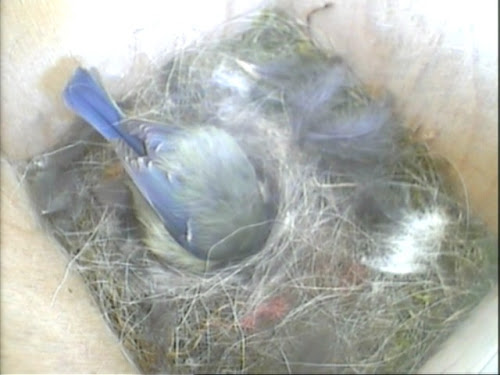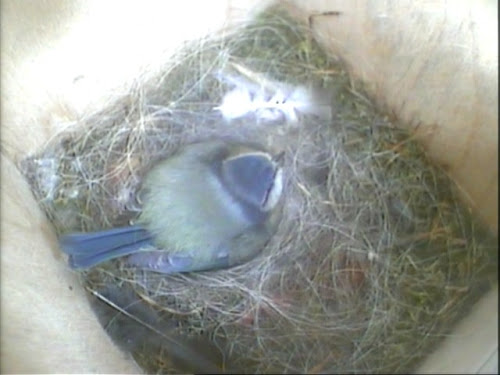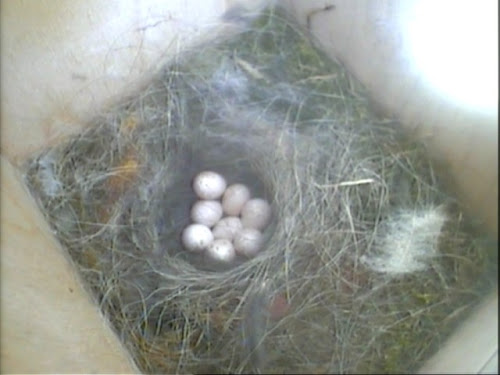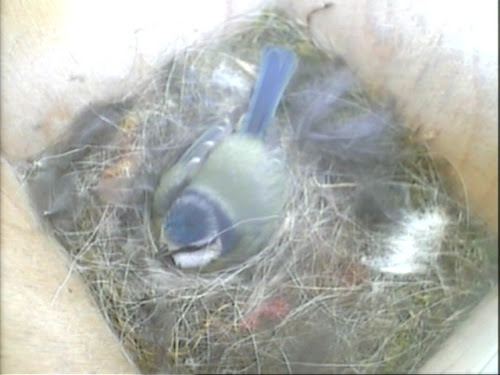As I suspected the count of blue tit eggs in our Camera Nestbox stopped at eight. I know of other Nestboxes with a few more but I am hoping that having less mouths to feed will help the survival of all chicks. So now that incubation is underway how does the female pass the time?
 Day-time naps are one way of passing the time during the incubation of the eight eggs in the nest. Interestingly the female began incubating before the last two eggs were laid.
Day-time naps are one way of passing the time during the incubation of the eight eggs in the nest. Interestingly the female began incubating before the last two eggs were laid.
 Digging in the nest is another. I guess she is looking for any unwanted bugs but I suspect she is likely to turn the eggs at the same time. The nest cup is really getting quite deep now with firm walls.
Digging in the nest is another. I guess she is looking for any unwanted bugs but I suspect she is likely to turn the eggs at the same time. The nest cup is really getting quite deep now with firm walls.
 Patiently waiting for food deliveries from the male is another – although she does tend to call out for food too. Her call is quite quiet so I don’t know how the male actually hears her. Of course sometimes he doesn’t…
Patiently waiting for food deliveries from the male is another – although she does tend to call out for food too. Her call is quite quiet so I don’t know how the male actually hears her. Of course sometimes he doesn’t…
 So out she goes leaving the eggs for a short while. Sometimes she covers them up but not always. I have seen this pair feeding at the feeders together and flying from branch to branch in and out of my garden. I expect that they will be enjoying this freedom as whenever the chicks come they won’t have any free time at all! Sound familiar?
So out she goes leaving the eggs for a short while. Sometimes she covers them up but not always. I have seen this pair feeding at the feeders together and flying from branch to branch in and out of my garden. I expect that they will be enjoying this freedom as whenever the chicks come they won’t have any free time at all! Sound familiar?
 Before any naps and after any digging in the nest as she settles in the nest cup she looks like she is moving about to get more comfortable. However if you look more closely at her movements you will see she is repeating a rocking movement. What she is actually doing is turning the eggs with her feet. How clever – she is making sure all sides of the eggs keep warm!
Before any naps and after any digging in the nest as she settles in the nest cup she looks like she is moving about to get more comfortable. However if you look more closely at her movements you will see she is repeating a rocking movement. What she is actually doing is turning the eggs with her feet. How clever – she is making sure all sides of the eggs keep warm!
Okay, I’m sure you would rather see all this activity for yourself. Below I have a video compilation of the highlights from the last few days with some still photo captures too. So what can we expect this week? Well, I’d say more of the same with the female perhaps leaving the nest less often.
Blue tit nestbox updates, video 1:40 with background music, try 480p quality.
What would I like to see this week? I would like to see the blue tits discover and eat the dried mealworms that I put out in a feeder last night. I was told by someone at the RSPB last year that they don’t recognise mealworms as a food. However I have seen other nestboxes where mealworms have been brought in to feed the chicks. Last year in desperation I put out live mealworms when the chicks were dying to help the parents in their endless search for food. They didn’t take them and the dunnocks and blackbirds went away with mouthfuls.
I am estimating it will be another ten days or so before the eggs begin to hatch so I am hoping that the resourceful blue tits will see other birds taking the mealworms and then try them too. So this week I am hoping to see the male bring mealworms to the female in our Nestbox. I believe this source of food could be vital in the survival of the chicks if there are no caterpillars at the end of the month.
Argh… I have just opened the curtains to see the new feeder I put the mealworms in getting a bashing by the starlings. It claimed to be suitable for small birds and the ledge and area to eat from is small. However, the starling has a long beak and is gripping on for dear life and although slipping off also is still managing to knock the feeder about enough to get some out and knock the rest to the ground where others are running frantically around waiting. It is 7.50am and the feeder is empty! The container that I bought is also empty as I put the lot in. As the starlings are absolutely relentless in their greedy quest for food I will now need to remove that feeder from where it hangs. I hate to think the noise they made early this morning too. My planting of climbing roses are plan A to help feed the young chicks and this was plan B. I guess I will have to work on plan C now!!! Perhaps I should consider adapting the fat cake guardian as at the moment they cannot get in there.
The photos and video shown above were taken from my camera Nestbox this past week.
Hi shirl, The only real success I’ve seen to keep bigger birds from feed is to have a normal flat feeder for mealworms, and around it a cage, with openings small enough to let the blue tits in, but nothing else. The largest mesh chicken wire which I think is 31 or 50mm around a frame of bamboo will do or rigid mesh frame, as long as the hole is slightly bigger than a nest box hole they’ll use it and get used to it very quickly. Starlings are bright as ninepence, so make sure it’s tied down properly or they’ll be in. Either that or 24/7 security guards 🙂 Good luck.
I imagine the little House Wren outside my window doing much the same as what you describe your Tits doing.
That’s very interesting about the RSPB saying they don’t recognize mealworms as food…certainly for the first few days after hatching ours did not feed mealworms to the chicks, not even mini ones, but the parents quite happily ate mealworms for themselves. Somewhere down the line they’ve realised they can feed mealworms to the chicks, but was it instinct, or adaptive intelligence I wonder ?
Martin
actually I’m wondering if the RSPB said they don’t recognize dried mealworms as food, in general that could be right; when live mealworms die they tend to go rigid and I notice our bluetits don’t take those because dead mealworms may have died through disease and could make the chicks ill
Hi again Border, Lisa and Martin 🙂
Border – Argh… the starlings are screeching their beaks off as I write this! Thanks for the suggestion. Yes this is something I have considered. However I am happy to share my garden with the birds but I’ve already a reasonable quota of feeders for adding more. I think the ideal answer is to have suitable plants to provide the insects that the starlings wouldn’t be interested in. Yippee – I’ve greenfly on my new roses! That being said I may yet try out a ground cage and loose a feeder to discourage the starlings – if that is at all possible!! This morning I saw my first juvenile blackbird this year – at my small pond. This area seems to attract the young birds. I am having great difficulty in keeping up with food at the feeders at the moment. BTW did you see that ‘our favourite’ green is the colour at Chelsea this year 😀
Lisa – I bet it is and without seeing this we would never know. Looking forward to seeing photos of your juvenile American Robins if you or DB get some 😀
Martin – Yes, I thought so too. I emailed the RSPB after all our chicks hatched last year. I asked “for any advice about the possible food shortages for the Blue Tits this year and about providing mealworms. Ian Peters, Wildlife Advisor, Bedfordshire replied: “Unfortunately, the recent weather combination of cool and wet conditions is the worst possible situation for blue tits during the fledgling development stage. The caterpillars are there but they can be difficult to find and because the food demands for the growing brood are so high, they can quickly die even though they are still getting a little food. Longer periods of bad weather can mean almost 100% failure of nests across the country in some years, especially as blue tits have such a distinct breeding season. Fortunately, the temperature has now risen and some places in the country are experiencing drier conditions, which are perfect for caterpillars.” He added: “Mealworms are a potential solution for bad times but blue tits are so conditioned to looking for caterpillars that many individuals fail to recognise the food.” It was live mealworms I put out last year although I am trying dried ones at the moment. I understand what you are saying. At the moment the blue tits are more interested in the spiders etc around the ledges of my shed. This shed is being replaced next week so I hope they find the wonderful tasty greenflies on my new rose 😀
Shirl, this is fantastic. Nature at her finest. I watched the video twice and thought it quite moving — it’s so sweet to watch the Mom settle on the eggs…and the Dad almost looked as if he were giving her a quick kiss before heading out the door “to work”. 🙂 Wondrous, in the truest sense of the word. Thanks for giving us all the opportunity to share in this miracle.
Hi again Nancy 🙂
Thank-you, I do hope there is much more to come. Wouldn’t it be wonderful to see all eggs hatch, then the chicks grow and fledge.
I agree it is quite touching to see the interaction between the pair. Just wait until you see them both looking over the nest at the chicks together! You are most welcome. I am delighted that I can 😀
What a beautiful video, thanks for sharing it.
wow, i can’t wait until the eggs hatch! we are dealing with dead sparrow fledglings right now… sad time, but some do make it.
Hi there Lisa & em 😀
Lisa – Thank-you! I’m glad you enjoyed it. Have a great weekend 😀
em – Well as I am late with this reply the eggs are now hatching. We still have one or two to go but I expect they will hatch today. Oh sorry to hear about your sparrows. We have some juveniles in the garden getting fed by parents at the moment and they are such lovely little birds. What a shame. We may lose our blue tit chicks yet as they female is not finding caterpillars and the male is completely off the scene. I have put out live mini mealworms but she has to find them and if she does the chicks could be okay. Nature can be hard as well as amazing. Have a great weekend 😀